The new educational frontier: Spoken word, written word, cyberword - the newest challenge of higher education
 Francis
A. Waldvogel
Francis
A. Waldvogel
President, Board of Swiss Federal
Institutes of Technology
Zürich/Lausanne (Switzerland)
Presented as a key-note lecture at the 19th ICDE World Conference in Vienna, Austria, June 20-24, 1999
© EURODL 1999
Abstract
Introduction
Knowledge, society and education today: a new paradigm
The first information revolution - Gutenberg
Higher education and information technology
Challenges and risks of the information and communication
technologies in higher learning
Conclusion
Abstract
The paper presents a comparative analysis of two major information revolutions: the Gutenberg revolution and the revolution brought about by today's fundamental changes of information and communication technologies. It discusses the challenges, opportunities and risks of the new technologies for universities and higher learning. Our universities need today a paradigmatic shift in order to fulfill their tasks of diversified, permanent education. However, this calls for a wide range of interdependent changes, and the risks should not be underestimated.
Key words:
Information and communication technologies, information
revolution, higher education, universities
Introduction
Universities have been for centuries the temples of higher education: Whereas their existence has been rarely disputed, their activities have been always linked to educational, social and philosophical debates. This potential conflict situation is easy to understand, since universities are by nature in the epicentre of several counteracting forces:
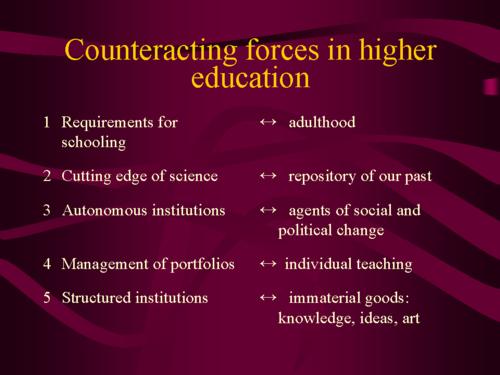
Slide 1
- Universities are educational places for adults, but the requirements for schooling and adult learning are difficult to reconcile.
- Universities are supposed to be at the cutting edge of new scientific discoveries but they are also the main historical repository of important concepts and discoveries of our past.
- Universities are supposed to be autonomous and independent learning institutions, but are considered at the same time to be the agents of future social and political changes of our society.
- Universities are important employers, managing impressive portfolios and relying on a corporate identity, but are simultaneously trying to focus on individual teaching and learning.
- Universities are well established and structured institutions, but handle at the same time the most immaterial human goods: knowledge, ideas, art.
These . often counteracting . forces are nevertheless important structural elements of higher education. Of course, universities do not stand by their own, and political factors have exerted over the years their modulating effects: The governance of the universities has been at times empowered by a centralized, presidential structure, whereas it has been guided at other times by a democratic body; the historical perspective has been prioritized in some universities, whereas other institutions have taken a future oriented, purely scientific and/or technological pathway; socratic dialogue has been preferred under certain circumstances as opposed to class teaching; and dark political times have shut down, for a limited period of time, their intellectual production, and stifled their creativity.
In recent years however, new societal scientific and technological developments are redefining the essence of higher education and are simultaneously warning us from the doom of conventional higher, institutional education: In today. s society, knowledge is becoming, just as health and freedom, an essential acquisition of each individual; moreover, knowledge has become a must in order to survive economically in a competitive market. Higher education limited to 4-6 years in early adultood, as it is presently the case, is not providing the necessary fund of knowledge any more for a full, productive career and its new requirements. Life-long learning at all levels of education will become necessary to meet the challenge of adaptation to new working and living conditions.
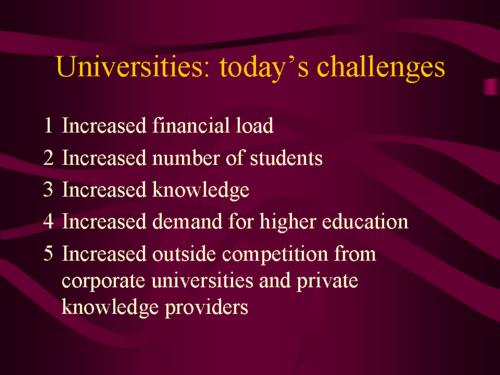
Slide 2
In this new competitive world, universities are still entangled in their own framework, shaped by history:
- They are struggling to find the solutions to their present problems of increased financial load,
- increased number of students,
- increased knowledge storage, retrieval and transmission,
- increased demand for higher education, and
- increased competition from corporate universities and private knowledge providers.
In one word, our universities need today a paradigmatic shift, in order to fullfill their tasks of diversified, permanent education in a new world where their adaptation has been incomplete.
Knowledge, society and education today: a new paradigm
Today. s information and communication systems are - as everybody would agree - reshaping our society. Basically, this phenomenon is not new: Information and communication are in fact the technology driven expansion of two fundamental human attributes . knowledge and language.

There has been throughout history a permanent need to expand, and disseminate language as a communication system, in order to keep pace with the transmission of another fundamental attribute of mankind, acquisition of knowledge. Knowledge production, storage, retrieval, exchange, transport and acquisition have always required, besides language, new media systems for their transmission; and these have deeply shaped our environment: Writing, printing, telephone, file transfer systems, television and lately the Web have been the most striking examples of this knowledge transmission evolution. If we live now in a so-called communication society, it is a misnomer since there cannot be a society without communication. It is only the intensity, the richness and the diversity of this communication which makes our society unique: Society and communication have always been, and will be for ever, linked to each other in a reciprocal relationship. Society is communication between individuals.

If the degree of networking and the extend of communication make our modern society a special case, it is only due to the unprecedented speed of its development . less than a generation . in comparison with, for instance, the invention of writing.

This cultural event which occurred simultaneously both in China and in the Golden Crescent of the Eastern Mediterranean 5000 years ago, was the first attempt to store and exchange information over distance and time and took 200 000 years to develop after the invention of speech . clearly an impressive period to adapt to a new communication system.
The first information revolution . Gutenberg
Of all the discoveries which shaped our planetary information and communication system, I believe that the most important one was the invention of the press in Mainz by Johann Gutenberg in 1457.
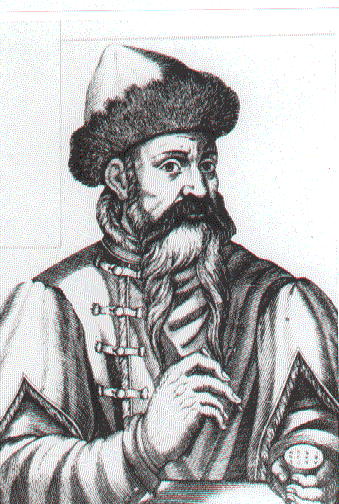
What was the essence of Gutenberg. s pioneering work?
The Gutenberg press changed the world immediately, rapidly and drastically. It perfected and unified script, and made it easy to read; it allowed the rapid production and diffusion of reading materials:

The process of writing one single book had taken up to one whole year of work in previous times. The new technology allowed new information and theories to be shared not only locally but also at distance. The price of books also decreased, and the number of printing offices increased rapidly: 30 years later, and only in Venice, which at that time was one of the european capitals regarding culture and trade, 150 printing presses were already working in full gear to keep pace with the growing demand for educational and cultural materials.
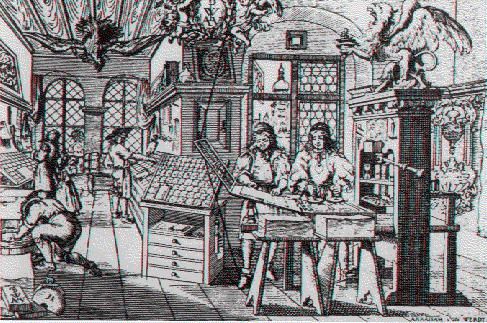
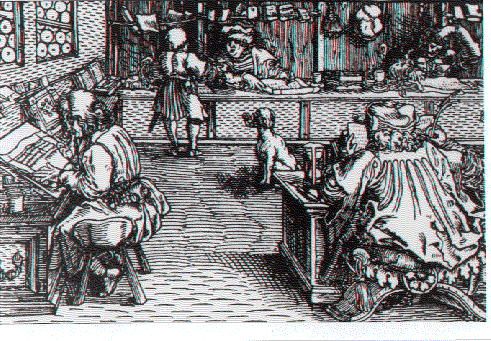
Our world was beginning to share its knowledge, the price of education decreased steeply . and culture became available to the average individual.
In addition, this revolution has led, in essence, to all forms of communication we use today: Neither newspapers, nor television, computers, videos would be conceivable without written texts which can be distributed freely and unexpensively. If Gutenberg had not invented the movable types, and if we were still to use manuscripts, we would not have reached by no means the scientific and technological levels achieved today.
Gutenberg. s discovery did not occur haphazardly: it was - like all fundamental discoveries . through a fruitful interplay between creative . albeit separate . human activities that the concept of printing books emerged. Books were previously written by monks, scholars and scribers and were produced at high cost . about the price of a wellsized farm for each volume. Gutenberg, who came from an educated family, learned to read as a child already . an unusual opportunity in these days . and read all the books his parents owned.

Slide 3
In addition, Gutenberg trained as a jeweller, cutting and polishing gemstones, and learned how to carve signs in hard metal in order to imprint the initials of the craftsman on softer jewelry. Fully carved wooden frames, reproducing a full book page, were already available at that time. It was Gutenberg. s genius which led to the production of single metal types for each letter of the alphabet to be printed. The press he used was adapted from a usual wine and cheese press. The composition of ink was derived from Flemish techniques for the preparation of pigments for painting: And Gutenberg. s putting together of all these established techniques led to one of the most important discoveries of mankind.

The Gutenberg bible was published in 1456. In 1500, there were more than 1000 print shops in Europe, paving the way for the critical writings of Martin Luther and . much later . to the sharp analyses of society by Locke, Voltaire, Montesquieu: A new age was in the move, putting the individual as a responsible personality in the center of society.
Let me sum up:
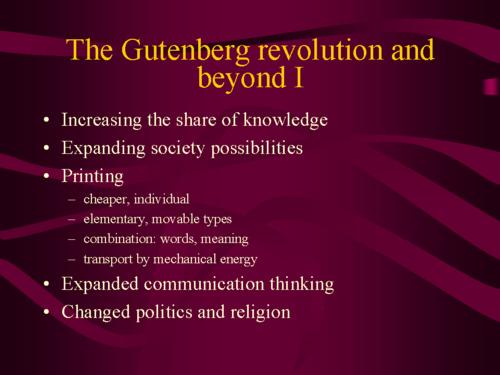
Slide 4
- An increasing volume of knowledge and a rapidly expanding society were the underlying forces for a better and richer human and societal interaction.
- The new print system invented by Gutenberg . cheaper, faster, individually targeted, conquered rapidly our society.
- Simple in its conception, it based on elementary movable types which could be placed sequentially to produce words, sentences, meaning . a typical application of combination theory. It used the most easily available energies, mechanical and transport.
- And in a few decades, it changed dramatically communication, learning, thinking .
- and even politics, religion and spirituality.
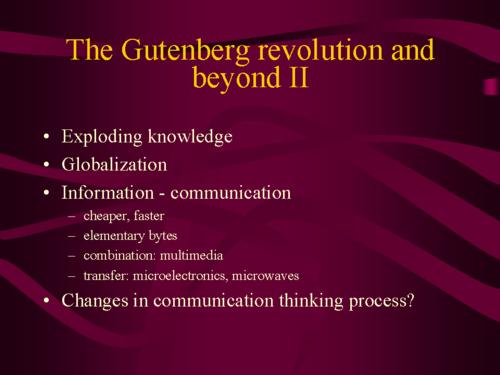
Slide 5
The parallelism with the changes we are witnessing today with the development of the new information and communication technologies is so striking that it is almost awsome in the way we may predict our own future.
- The new information and communication network, of this century, . cheaper, faster, individually targeted, is conquering rapidly our society.
- Simple in its conception, it is based on individual elementary bytes, which placed sequentially produce meaning, images, sound . the multimedia.
- The system uses the cheapest available energy system . microelectronics and microwaves.
- It has already changed our way to communicate, and will change our way of learning, thinking . possibly politics, religion and spirituality.
Higher Education and Information Technology
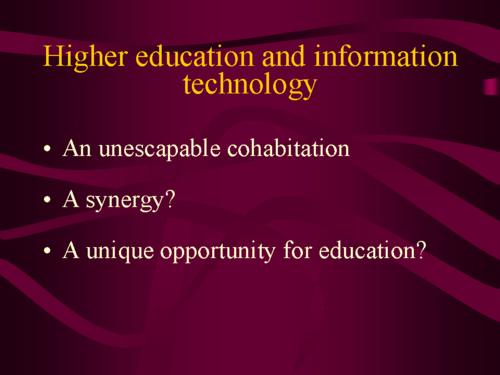
Slide 6
Teaching and learning, just as many other human activities and commodities such as commerce, banking, interpersonal communication, are now inbedded in a networked world. There is no other alternative. Since higher education . as mentioned earlier . is simultaneously confronted with many new challenges which our university system cannot solve within its preestablished framework, it is worth exploring to which extent our educational system could benefit, or even be reorganized by this new network which is deeply reshapening our society in other disciplines. To put it bluntly, it is my hypothesis . or my belief . that the new information and communication technology will save our ailing universities. It will soon provide us - hopefully under the auspices of a restructured university . with new programs of basic and life long learning, with new teaching/coaching methodologies, leading to creative and interpersonal contacts and acquisition of knowledge; and to the possibility of individual professional quality control. The future student will use his/her PC as a learning station, as a coaching/tutoring system, as an information provider, as a communication center. Teachers and Professors will enjoy returning to the core activities of education, i.e. to the establishment of concepts and principles of knowledge acquisition; they will teach again critical analysis of data and reports, and confront students with problems and questions testing their levels of understanding, of social and ethical concern. The passive classroom will evolve into active studio learning, and the confrontation of teacher/student will be restructured: Time saved by anonymous teaching in front of dozing students will be devoted to a humane, personal relationship . a perfect world!
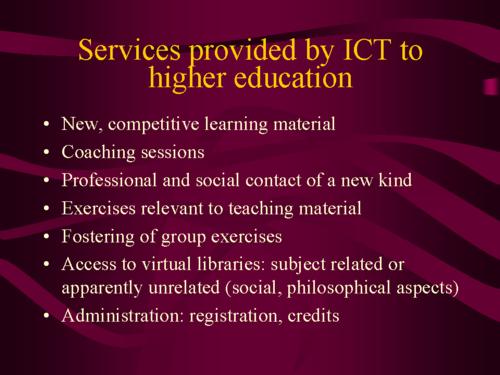
Slide 7
As it has been now amply demonstrated, the contents which can be delivered in a reshaped system of higher education over the information network system are manyfold:
- The student will be offered learning material, as well as coaching sessions.
- Interpersonal professional contacts, social contacts of a new kind will be fostered.
- The creation of problem oriented exercices and case studies will favor group activities and community work.
- Access to a variety of virtual knowledge storage systems will also be fostered such as to libraries, to other communication networks, to research protocols linked with the learning assignments, to other apparently unrelated, but socially, ethically or philosophically related materials.
- Finally, access to administration . application, choices of courses, indication of credit system . which are all time and workforce consuming activities, will be saved and reallocated to interpersonal activities.
It has been argued that such a revolution in the higher educational system may be technically interesting, but may not offer any advantage over the classical curriculum; in addition, it may lend itself to a variety of perversions of learning activities and student life. The risks linked with such a reorganization of the university system should certainly not be underestimated, nor dismissed; neither should their potential advantages be taken for granted. In the following section, requirements and challenges of the information and communication technology based learning system will be analyzed in more detail.
Challenges and risks of the information and communication technologies in higher learning
It is expected that in 10 years, personal computers will be wireless, permanently with us, answering to voice messages, responding to written information. Computers will listen, see and learn. They will be organized in order to provide the single citizen-learner with extensive surfaces through a single point of contact; and, most importantly, they will evolve in order to let people interact naturally and . user-friendly", with this worldwide digital nervous system. This also means that this development is a unique opportunity for psychologists, didacticians, linguists and sociologists for new research activities pertaining to the understanding of cognitive functioning, to the modelling of knowledge presentation, to language interactions, and to the analysis of group interaction as a learning process. The old problem, and the new quest of a closer interaction between natural sciences, humanities and society could find here a new research space for common mutually stimulating activities.
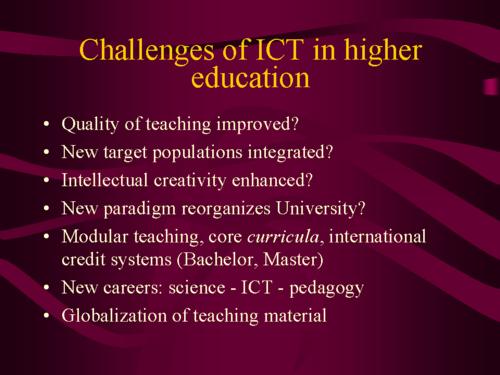
Slide 8
Before getting to these ideal green pastures of the future however, the challenge is considerable for our higher educational systems. Goals have to be set to justify, evaluate and monitor this change of paradigm:
- In order to survive, the new system must improve the quality of teaching,
- and has to integrate new target populations in the teaching process.
- It has to demonstrate that it increases the intellectual independence and the creativity of students, allowing them to act as managers of their own knowledge acquisition . but such evaluation tools are presently unavailable and have yet to be developed.
- In addition, the new education system has to be integrated as a new, general didactic concept, reorganizing the university as a whole, whilst finding its specific adaptations for each faculty:
- The introduction of single, fragmented courses, poorly integrated into the general teaching concept, has been shown to create frustrations and misunderstandings among students and teachers. This entails an evolution towards a modular organization of the teaching materials and of the procedures, their integration into core curricula and credit systems for diplomas, based on international standards and titles such as Bachelors and Masters.
- Also, the new higher educational system should not be a substitute but rather a complement to the usual conventional teaching methodologies: As a consequence, we need to develop new careers, based on a triple combination of solid training in natural sciences or humanities, complemented by basic and extensive knowledge in communication and information technologies, and topped by an education as an educator. This new breed of educators will have to establish which learning technique is appropriate for which field of knowledge, will have to determine standards of quality and approprieteness, and will review teaching materials obtained from private, non academic, or public institutions for possible integration into the local lecture material. Part time activity, social and educational concern, possibility of home work make this new profession an ideal objective for feminine careers in the higer educational system.
- Additional challenges have to be met: The academic system is already under pressure from media giants, which are trying to expand their global network and to capture part of the lucrative distance learning market which is estimated at US$ 300 billion/year. In its full development, the booming commercial network system will allow students to take their courses in other countries and count them towards their own degrees . an accepted procedure if the contents and exercices of the courses meet the local standards. This new way of knowledge acquisition however will break the classical image of our universities: No walls, no limits, no lecture schedule. Finally, the system will be required to extend its services far beyond the university boundaries and far into the future: it has to reach new student populations, not necessarily diploma-bound, new social groups, and has to provide new materials adapted for life long learning.
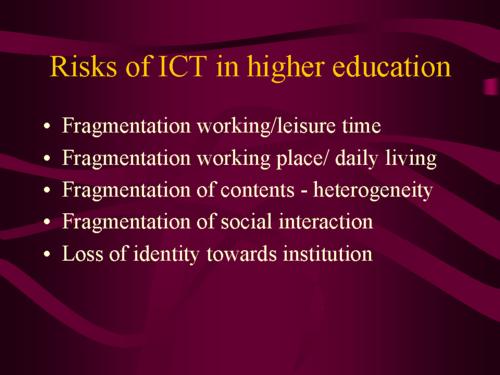
Slide 9
This ongoing revolution is not without risks. The most important one is fragmentation:
- fragmentation of working time and leisure time in front of the screen, with poor separation between the two activities;
- lack of distinction between work place and activities of daily living;
- fragmentation of contents, as already observed with problem oriented learning, leading to a heterogenous knowledge base;
- and, most importantly, fragmentation of social interactions between students, students and teachers, the academic community. The latter risk can be avoided by recreating strong teacher-student individual contact time. Conventional teaching time saved should be systematically reallocated and shifted towards more social interaction and questioning.
- Another risk to consider is the loss of student identity who may not feel belonging to a specific institution any more, but rather to a anonymous consortium of knowledge providers. This will increase their loss of confidence already favored by their confrontation with the world of adult learning.
Here again, there is a new field of research to be developped, a new assessment system of the information and communication technologies, trying to analyze their impact on the learning society.
Conclusion
While we are witnessing an escalation in the infrastructures and performances of information and communication technologies, while the private sector is becoming a major provider of new teaching materials, our university system has started many experimental projects in distant learning, but has yet to develop full scale concepts and to initiate the necessary paradigmatic shift to become a partner in tomorrow. s networked teaching world . which expands way beyond our universities.
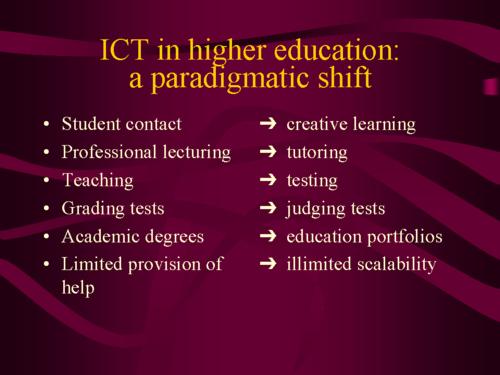
Slide 10
The incentives and advantages of the new educational system are nevertheless numerous and impressive:
- From student contact hours to creative learning time,
- from professorial lecturing to tutoring,
- from teaching to testing,
- from grading tests to judging tests,
- from academic degrees to portfolios of education,
- and from limited provision of help to illimited scalability
Exchange of knowledge in the networked world surely is revolutionizing our knowledge and culture and may represent the second Gutenberg revolution.

